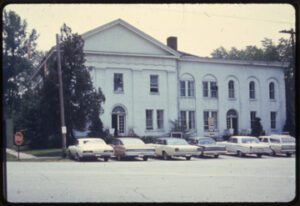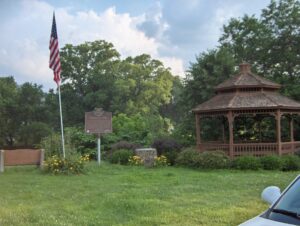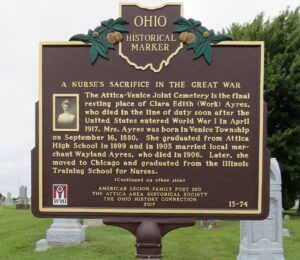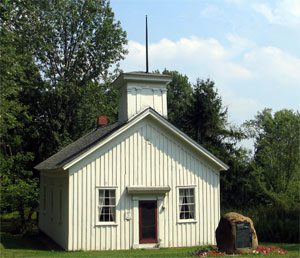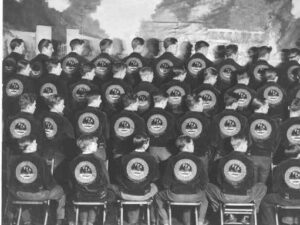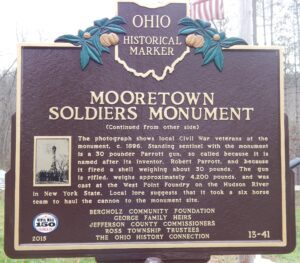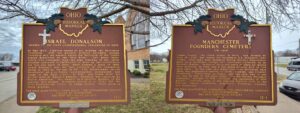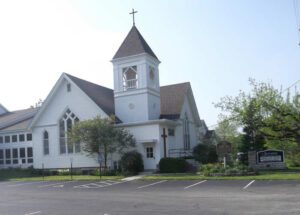, OH
Mahoning County was created in 1846 by combining townships from southern Trumbull and northern Columbiana counties. Canfield engaged in competition with several surrounding communities for the new county seat, and its success was attributed to its central location along with the state and local political influence of Judge Eben Newton and Elisha Whittlesey, Esq., Comptroller of the United States Treasury from 1849-1857. To become the county seat, the State of Ohio required “a suitable lot and $5,000 toward public buildings” Judge Newton donated the land and spearheaded the subscription of the state required bond. Once attained, construction progressed rapidly on the Classical Revival style courthouse, completed in June 1848. The Italianate style West wing was added in 1862, but its government status was challenged when in the early 1870s, Youngstown, by now a city, resumed its earlier challenge for the county seat. (continued on other side)
, OH
First surveyed in 1849, Powhatan Point was laid out by Franklin Knox. The “point” is the confluence of Captina Creek and the Ohio River. The small but thriving river and farming community served York Township and the rich Captina Valley as a shipping center for its first 75 years. Given impetus by the construction of the Powhatan Enterprise Flouring Mill and Woolen Factory in 1850, local businesses shipped grain, fruit, lumber, cheese, whiskey, livestock, wool, and tobacco to northern and southern ports. There were three boat landings: Boger’s, Hornbrook’s and Dorsey’s, each equipped with an incline car track from the warehouses to the river’s edge. With the opening of North American Coal Corporation’s Powhatan No. 1 Mine in 1922, the village became a mining community that continued to rely on the river. A disastrous mine fire took the lives of 66 men on July 5, 1944.
, OH
The Attica-Venice Joint Cemetery is the final resting place of Clara Edith (Work) Ayres, who died in the line of duty soon after the United States entered World War I in April 1917. Mrs. Ayres was born in Venice Township on September 16, 1880. She graduated from Attica High School in 1899 and in 1903 married local merchant Wayland Ayres, who died in 1906. Later, she moved to Chicago and graduated from the Illinois Training School for Nurses. (Continued on other side)
, OH
Called the “Cradle of Equal Suffrage” and “Free Speech Chapel,” Union Chapel was to be “…open and free for all denominations, but to be monopolized by no one or to the exclusion of anyone.” Built in 1858 or 1859 on land donated by Anson Matthews, the chapel reputedly exists in response to incident triggered by James A. Garfield, then principal of the Western Reserve Eclectic Institute (now Hiram College) and later president of the United States. He was scheduled to speak at the Congregationists’ “Brick Church” in December 1857. Because of the supposed controversial nature of Garfield’s speech, however, the invitation was withdrawn. (Continued on other side)
, OH
The blue corduroy jacket worn by members is a widely recognized symbol of the National FFA Organization, formerly Future Farmers of America. In 1933, Dr. J.H. “Gus” Lintner, a Fredericktown teacher and advisor to the local FFA chapter, commissioned a jacket for its members to wear to FFA’s national convention in Kansas City, Missouri. Impressed by the design, the organization adopted the jacket as part of FFA’s Official Dress. Millions of members have worn it since. Founded in 1928 to promote agricultural education, FFA continues its mission in 2018 in all 50 U.S. states and two territories.
, OH
In 1871 Robert and Martha McLaughlin George erected a Soldiers Monument in the memory of their son Thomas and other soldiers from Ross Township, Jefferson County, Ohio who died in service to the United States during the Civil War. All were native to Ross Township and some, like 25 year-old Thomas George, were members of Company K, 2nd Ohio Volunteer Infantry. Captain David Mitchell commanded Company K, whose recruits came from Mitchell’s Sald Works (Holt) and Yellow Creek. The unit fought in many battles, including Perryville, Kentucky, Stone River, Tennessee, Chickamauga, Georgia, and in the Atlanta campaign. Corporal Thomas George was killed at Perryville on October 8, 1862. Many of his comrades were killed in battle; others parished from disease or died as prisoners of war.
, OH
In May 1800, Congress passed an act dividing the Northwest Territory, with the western division becoming Indiana Territory and the eastern called the Territory of the United States northwest of the Ohio River. Two years later, thirty-five delegates from the nine counties of the latter division convened in Chillicothe to draw up the constitution for the new state of Ohio, which became a state in 1803. Israel Donalson was the last survivor of the convention dying in 1860 at the age of 93. This frontiersman served Manchester as a surveyor, schoolteacher, postmaster, and judge in the first court. In 1791, one month after his arrival here at Massie’s Station, Donalson was captured by Native Americans. His memoir is a colorful account of his capture and escape. Donalson served as an Elder for the first Presbyterian church in Adams County, which stood on these grounds.
, OH
Company E of the 30th Ohio Volunteer Infantry was the only full infantry company formed in Jerome Township. Capt. Elijah Warner organized the unit in the village of Jerome and it was mustered into the Union Army at Camp Chase in Columbus on August 29, 1861. A total of 102 men from the township fought in the regiment throughout the war, while approximately 25% of the total population of the Jerome Township served. Company E performed outstanding service, participating in the Antietam, Vicksburg, and Atlanta Campaigns, Sherman’s March to the Sea and the March through the Carolinas, and the in the Grand Review in Washington, D.C. Of the 102 Jerome Township men in Company E, 32 perished during the war. The regiment was mustered out of service August 13, 1865.


